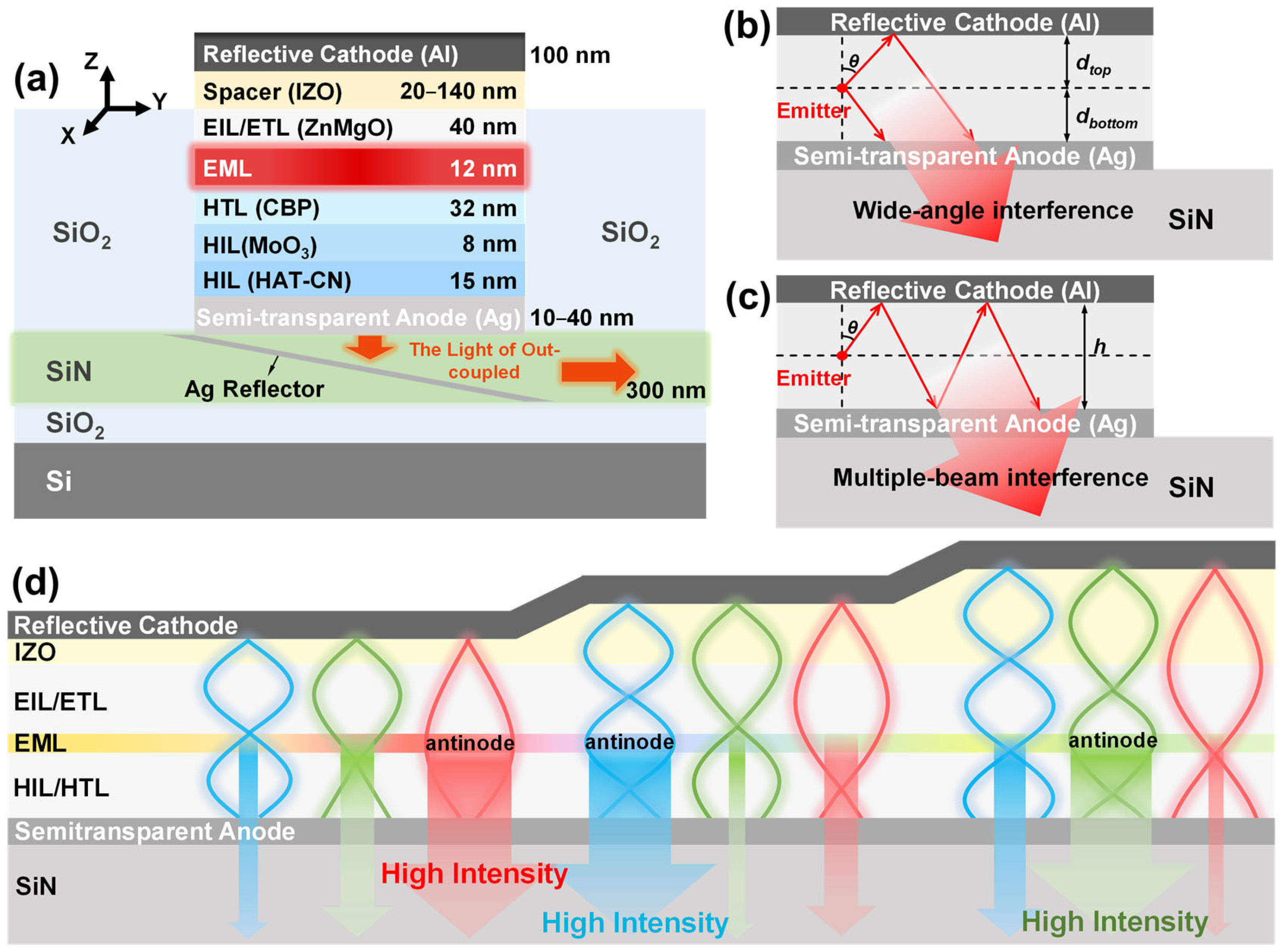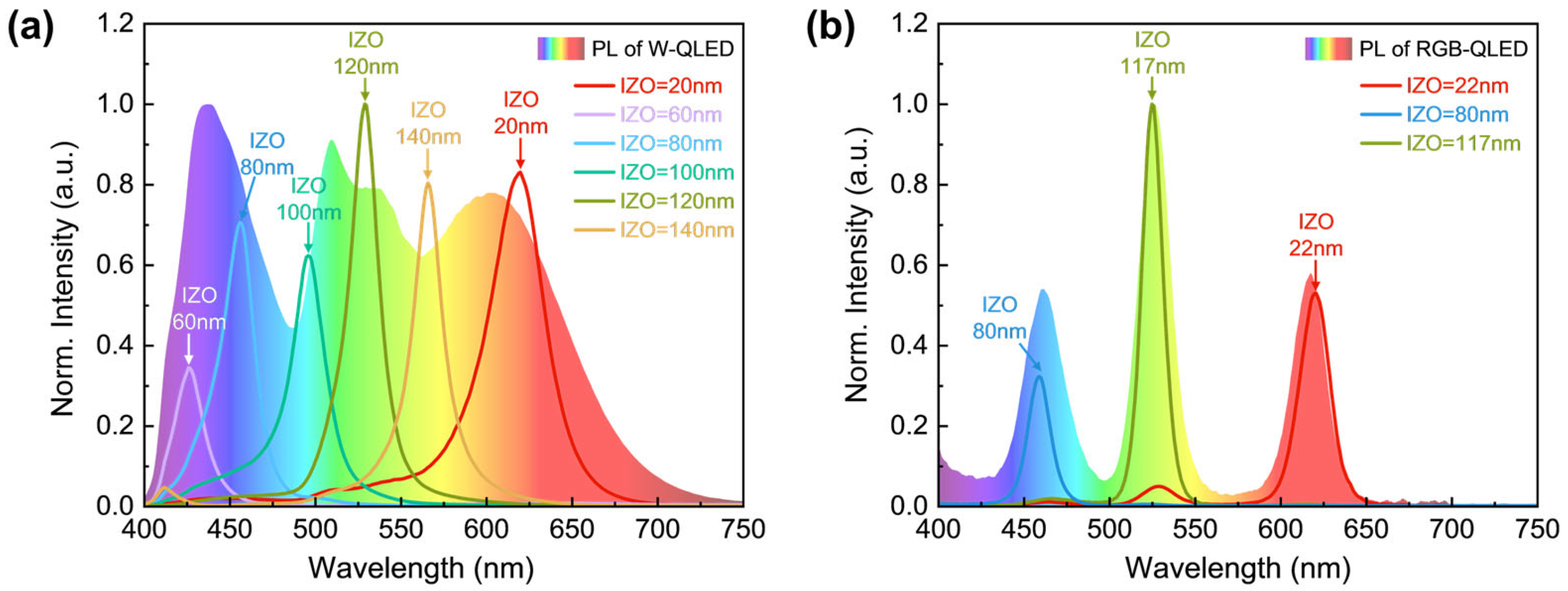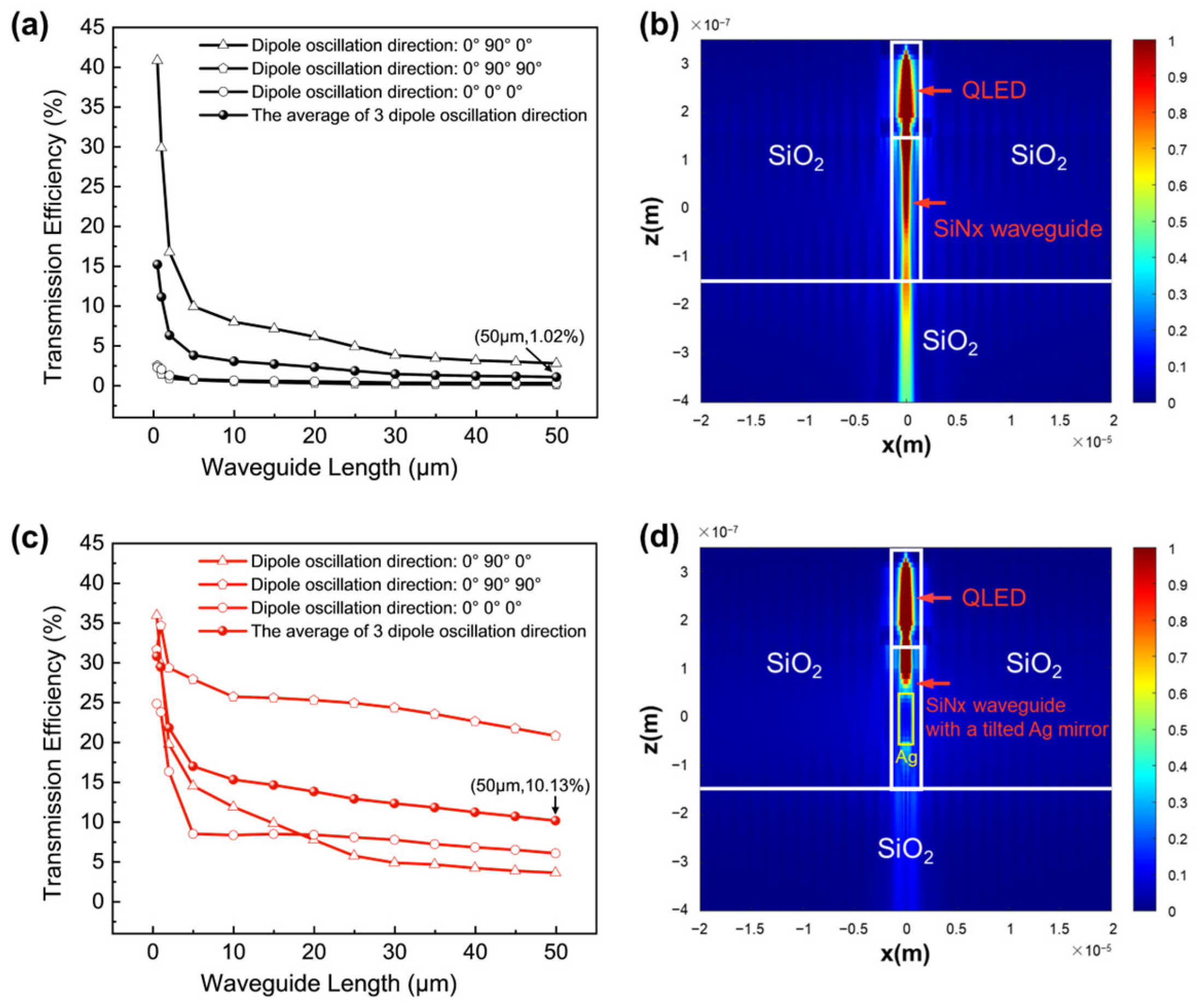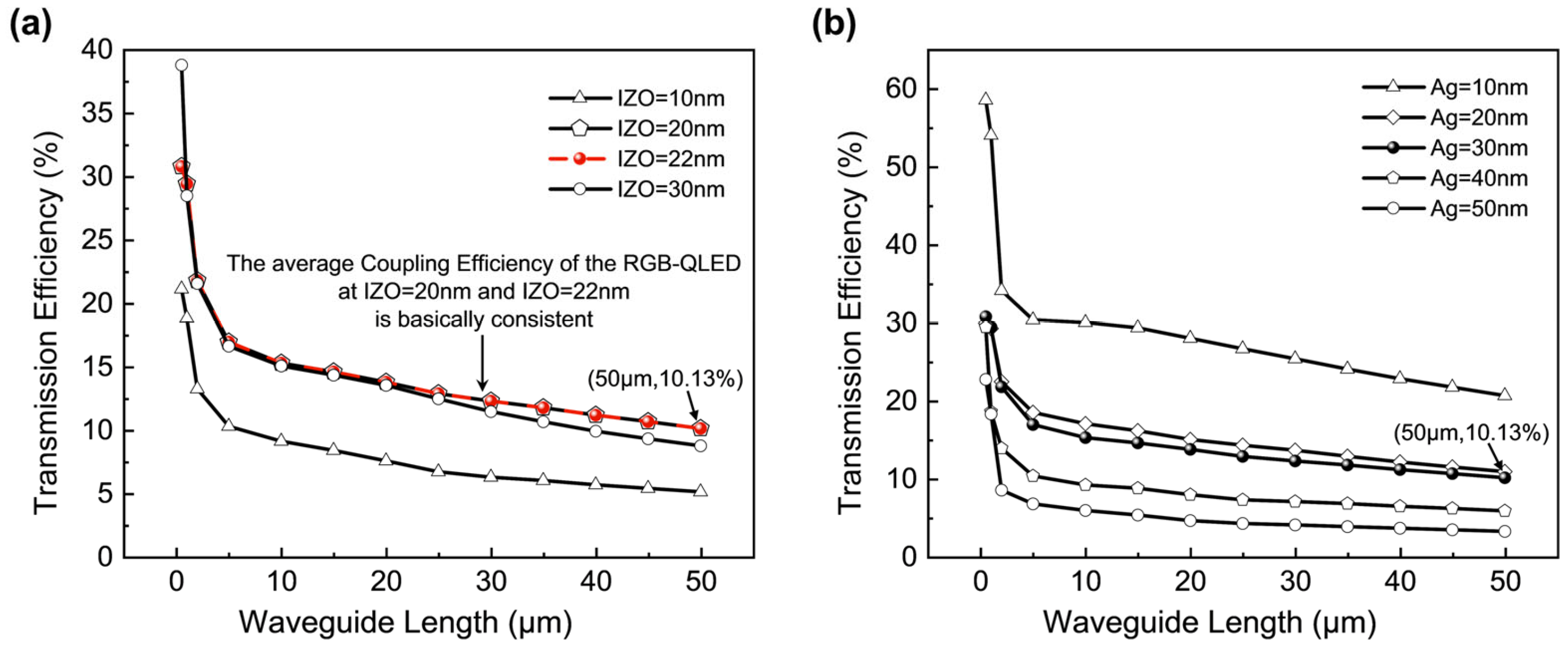Waveguide Coupled Full-Color Quantum Dot Light-Emitting Diodes Modulated by Microcavities
Abstract
1. Introduction
2. Theoretical Approach
3. Numerical Results and Discussion
3.1. Spectral Tunability for QLED Coupled with SiNx Waveguide
3.2. The FWHM Bandwidth Narrowing for QLED Coupled with SiNx Waveguide
3.3. Angular Distribution for QLED Coupled with SiNx Waveguide
3.4. Output Efficiency of RGB-QLED Coupled with SiNx Waveguide
4. Conclusions
| Technology | FWHM (nm) | Output Efficiency (%) | Reference |
|---|---|---|---|
| RGB-QLED (this work) | 14.39 | 10.13 (SiNx) | / |
| W-QLED (this work) | 21.1 | 1.02 (SiNx) | / |
| QLED | 35 | 0.08 (SiNx) | [24] |
| InGaAsP LED | 25 | 0.01–1 (InP) | [46] |
| Black phosphorus LED | 423 | 0.084 (Si) | [47] |
| Technology | FWHM (nm) | NTSC 1953 Coverage (%) | Reference |
|---|---|---|---|
| RGB-QLED (this work) | 14.39 | 110.76 | / |
| W-QLED (this work) | 21.1 | 91.19 | / |
| OLED | 20 | 125.6 | [48] |
| Perovskite LED | 15 | 129 | [49] |
| Perovskite QLED | 16 | 132 | [50] |
| Phosphorus LED | 61 | 96 | [51] |
| GaN mini-LED | ~25 | 113.63 | [52] |
Supplementary Materials
Author Contributions
Funding
Institutional Review Board Statement
Informed Consent Statement
Data Availability Statement
Conflicts of Interest
Abbreviations
| QLEDs | Quantum dot light-emitting diodes |
| FWHM | Full-width at half-maximum |
| TIR | Total internal reflection |
| SiN | Silicon nitride |
| W-QLED | white light QLED |
| RGB-QLED | mixed RGB QDs |
| EML | Emitting layer |
| IZO | Indium zinc oxide |
| HIL | Hole injection layer |
| HTL | Hole transport layer |
| ETL | Electron transport layer |
| QDs | Quantum dots |
| CPS | Chance, Prock, and Sibley theory |
| FDTD | Finite difference time domain |
| CIE | The International Commission on Illumination |
| PL | Photoluminescence |
| HSL | Hue, saturation, and luminance |
| NTSC 1953 | National Television System Committee 1953 |
| sRGB | Standard Red Green Blue |
Appendix A. Refractive Index of All Materials Used
References
- Zhang, Z.C.; You, Z.; Chu, D.P. Fundamentals of phase-only liquid crystal on silicon (LCOS) devices. Light-Sci. Appl. 2014, 3, e213. [Google Scholar] [CrossRef]
- Yin, K.; Hsiang, E.-L.; Zou, J.; Li, Y.; Yang, Z.; Yang, Q.; Lai, P.-C.; Lin, C.-L.; Wu, S.-T. Advanced liquid crystal devices for augmented reality and virtual reality displays: Principles and applications. Light-Sci. Appl. 2022, 11, 161. [Google Scholar] [CrossRef] [PubMed]
- Li, C.; Feng, M.; Liu, J.; Liu, W.; Sun, X.; Liu, J.; Sun, Z.; Zhu, G.; Zhang, S.; Sun, Q.; et al. GaN-Based Resonant-Cavity Light-Emitting Diode Towards a Vertical-Cavity Surface-Emitting Laser. IEEE J. Sel. Top. Quantum Electron. 2025, 31, 1–6. [Google Scholar] [CrossRef]
- Huang, J.; Tang, M.; Zhou, B.; Liu, Z.; Yi, X.; Wang, J.; Li, J.; Pan, A.; Wang, L. GaN-based resonant cavity micro-LEDs for AR application. Appl. Phys. Lett. 2022, 121, 201104. [Google Scholar] [CrossRef]
- Liu, Z.; Ren, K.; Dai, G.; Zhang, J. A Review on Micro-LED Display Integrating Metasurface Structures. Micromachines 2023, 14, 1354. [Google Scholar] [CrossRef]
- Xuan, T.; Shi, S.; Wang, L.; Kuo, H.-C.; Xie, R.-J. Inkjet-Printed Quantum Dot Color Conversion Films for High-Resolution and Full-Color Micro Light-Emitting Diode Displays. J. Phys. Chem. Lett. 2020, 11, 5184–5191. [Google Scholar] [CrossRef]
- Lee, T.; Kim, B.J.; Lee, H.; Hahm, D.; Bae, W.K.; Lim, J.; Kwak, J. Bright and Stable Quantum Dot Light-Emitting Diodes. Adv. Mater. 2022, 34, 2106276. [Google Scholar] [CrossRef]
- Yuan, T.; Yuan, F.L.; Sui, L.Z.; Zhang, Y.; Li, Y.C.; Li, X.H.; Tan, Z.A.; Fan, L.Z. Carbon Quantum Dots with Near-Unity Quantum Yield Bandgap Emission for Electroluminescent Light-Emitting Diodes. Angew. Chem.-Int. Ed. 2023, 62, e202218568. [Google Scholar] [CrossRef]
- Kim, J.; Roh, J.; Park, M.; Lee, C. Recent Advances and Challenges of Colloidal Quantum Dot Light-Emitting Diodes for Display Applications. Adv. Mater. 2024, 36, 2212220. [Google Scholar] [CrossRef]
- Jang, C.; Bang, K.; Chae, M.; Lee, B.; Lanman, D. Waveguide holography for 3D augmented reality glasses. Nat. Commun. 2024, 15, 66. [Google Scholar] [CrossRef]
- Gopakumar, M.; Lee, G.-Y.; Choi, S.; Chao, B.; Peng, Y.; Kim, J.; Wetzstein, G. Full-colour 3D holographic augmented-reality displays with metasurface waveguides. Nature 2024, 629, 791–797. [Google Scholar] [CrossRef] [PubMed]
- Yoo, C.; Bang, K.; Jang, C.; Kim, D.; Lee, C.K.; Sung, G.; Lee, H.S.; Lee, B. Dual-focal waveguide see-through near-eye display with polarization-dependent lenses. Opt. Lett. 2019, 44, 1920–1923. [Google Scholar] [CrossRef] [PubMed]
- Elsinger, L.; Tanghe, I.; Acker, F.V.; Zawacka, N.K.; Petit, R.; Neyts, K.; Detavernier, C.; Geiregat, P.; Hens, Z.; Thourhout, D.V. A Waveguide-Coupled Colloidal Quantum Dot LED on a Silicon Nitride Platform. In Proceedings of the 2020 Conference on Lasers and Electro-Optics (CLEO), San Jose, CA, USA, 10–15 May 2020; pp. 1–2. [Google Scholar]
- Yokoyama, H. Physics and Device Applications of Optical Microcavities. Science 1992, 256, 66–70. [Google Scholar] [CrossRef] [PubMed]
- Rozenman, G.G.; Peisakhov, A.; Zadok, N. Dispersion of organic exciton polaritons—A novel undergraduate experiment. Eur. J. Phys. 2022, 43, 035301. [Google Scholar] [CrossRef]
- Gomez-Dominguez, M.; Kumar, E.J.; Koch, K.A.; Srimath Kandada, A.R.; Correa-Baena, J.-P. Materials and Cavity Design Principles for Exciton-Polariton Condensates. ACS Nano 2025, 19, 10579–10588. [Google Scholar] [CrossRef]
- Mei, G.; Wang, W.; Wu, D.; Surman, P.A.; Wang, K.; Choy, W.C.H.; Yang, X.; Xu, W.; Sun, X.W. Full-Color Quantum Dot Light-Emitting Diodes Based on Microcavities. IEEE Photonics J. 2022, 14, 8219709. [Google Scholar] [CrossRef]
- Zhao, H.A.; Arneson, C.E.; Fan, D.J.; Forrest, S.R. Stable blue phosphorescent organic LEDs that use polariton-enhanced Purcell effects. Nature 2024, 626, 300–305. [Google Scholar] [CrossRef]
- Huang, S.-H.; Su, H.-P.; Chen, C.; Lin, Y.; Yang, Z.; Shi, Y.; Song, Q.; Wu, P.C. Microcavity-assisted multi-resonant metasurfaces enabling versatile wavefront engineering. Nat. Commun. 2024, 15, 9658. [Google Scholar] [CrossRef]
- Mei, G.; Xiao, X.; Ahmad, S.; Lin, H.; Tan, Y.; Wang, K.; Sun, X.W.; Choy, W.C.H. Microcavity Design Upping Light Extraction Efficiency over 50% in High-Index Perovskite Light-Emitting Diodes. Adv. Opt. Mater. 2023, 11, 2300912. [Google Scholar] [CrossRef]
- Yu, P.C.; Topolancik, J.; Chakravarty, S.; Bhattacharya, P. Mode-coupling characteristics and efficiency of quantum-dot electrically injected photonic crystal waveguide-coupled light-emitting diodes. IEEE J. Quantum Electron. 2005, 41, 455–460. [Google Scholar] [CrossRef]
- Xu, X.J.; Maruizumi, T.; Shiraki, Y. Waveguide-integrated microdisk light-emitting diode and photodetector based on Ge quantum dots. Opt. Express 2014, 22, 3902–3910. [Google Scholar] [CrossRef] [PubMed]
- Ren, J.; Meijerink, A.; Zhou, X.; Wu, J.; Zhang, G.; Wang, Y. In Situ Embedding Synthesis of CsPbBr3@Ce-MOF@SiO2 Nanocomposites for High Efficiency Light-Emitting Diodes: Suppressing Reabsorption Losses through the Waveguiding Effect. ACS Appl. Mater. Interfaces 2022, 14, 3176–3188. [Google Scholar] [CrossRef] [PubMed]
- Elsinger, L.; Petit, R.; Van Acker, F.; Zawacka, N.K.; Tanghe, I.; Neyts, K.; Detavernier, C.; Geiregat, P.; Hens, Z.; Van Thourhout, D. Waveguide-Coupled Colloidal Quantum Dot Light Emitting Diodes and Detectors on a Silicon Nitride Platform. Laser Photonics Rev. 2021, 15, 2000230. [Google Scholar] [CrossRef]
- Steindorfer, M.A.; Lamprecht, B.; Schmidt, V.; Abel, T.; Mayr, T.; Krenn, J.R. Light coupling for integrated optical waveguide-based sensors. In Optical Sensing and Detection; SPIE: Bellingham, WA, USA, 2010; p. 77261S. [Google Scholar]
- Bulović, V.; Khalfin, V.B.; Gu, G.; Burrows, P.E.; Garbuzov, D.Z.; Forrest, S.R. Weak microcavity effects in organic light-emitting devices. Phys. Rev. B 1998, 58, 3730–3740. [Google Scholar] [CrossRef]
- Ye, T.; Tian, D.; Wu, D.; Sun, X.W.; Wang, K. Submicron quantum dot light-emitting diodes enabled by pixelated topological meta-mirror. Nanophotonics 2025, 14, 241–251. [Google Scholar] [CrossRef]
- He, P.; Lan, L.; Deng, C.; Wang, J.; Peng, J.; Cao, Y. Highly efficient and stable hybrid quantum-dot light-emitting field-effect transistors. Mater. Horiz. 2020, 7, 2439–2449. [Google Scholar] [CrossRef]
- Xiang, C.Y.; Koo, W.; So, F.; Sasabe, H.; Kido, J. A systematic study on efficiency enhancements in phosphorescent green, red and blue microcavity organic light emitting devices. Light-Sci. Appl. 2013, 2, e74. [Google Scholar] [CrossRef]
- Han, S.; Huang, C.; Lu, Z.-H. Color tunable metal-cavity organic light-emitting diodes with fullerene layer. J. Appl. Phys. 2005, 97, 093102. [Google Scholar] [CrossRef]
- Dodabalapur, A.; Rothberg, L.J.; Jordan, R.H.; Miller, T.M.; Slusher, R.E.; Phillips, J.M. Physics and applications of organic microcavity light emitting diodes. J. Appl. Phys. 1996, 80, 6954–6964. [Google Scholar] [CrossRef]
- Clarke, D. Appendix A: The Fresnel Laws. In Stellar Polarimetry; Wiley: New York, NY, USA, 2009; pp. 365–385. [Google Scholar]
- Tsai, D.-C.; Chang, Z.-C.; Kuo, B.-H.; Wang, Y.-H.; Chen, E.-C.; Shieu, F.-S. Thickness dependence of the structural, electrical, and optical properties of amorphous indium zinc oxide thin films. J. Alloys Compd. 2018, 743, 603–609. [Google Scholar] [CrossRef]
- Man, J.; He, S.; Shi, C.; Yang, H.; Wang, D.; Lu, Z. Optical design of connecting electrodes for tandem organic light-emitting diodes. Opt. Lett. 2020, 45, 3561–3564. [Google Scholar] [CrossRef]
- Schubert, E.F.; Hunt, N.E.J.; Micovic, M.; Malik, R.J.; Sivco, D.L.; Cho, A.Y.; Zydzik, G.J. Highly Efficient Light-Emitting Diodes with Microcavities. Science 1994, 265, 943–945. [Google Scholar] [CrossRef] [PubMed]
- Deppe, D.G.; Lei, C.; Lin, C.C.; Huffaker, D.L. Spontaneous Emission from Planar Microstructures. J. Mod. Opt. 1994, 41, 325–344. [Google Scholar] [CrossRef]
- Cao, J.; Liu, X.; Khan, M.A.; Zhu, W.; Jiang, X.; Zhang, Z.; Xu, S. RGB tricolor produced by white-based top-emitting organic light-emitting diodes with microcavity structure. Curr. Appl. Phys. 2007, 7, 300–304. [Google Scholar] [CrossRef]
- Alharbi, R. Reflectivity and Elastic Modulus of Nano-Aluminum Films on Silicon Crystal Substrates. Master’s Thesis, University of Waterloo, Waterloo, ON, Canada, 2014. [Google Scholar]
- Sun, X.; Hong, R.; Hou, H.; Fan, Z.; Shao, J. Thickness dependence of structure and optical properties of silver films deposited by magnetron sputtering. Thin Solid Film. 2007, 515, 6962–6966. [Google Scholar] [CrossRef]
- Chance, R.R.; Prock, A.; Silbey, R. Molecular Fluorescence and Energy Transfer Near Interfaces. In Advances in Chemical Physics; Wiley: New York, NY, USA, 1978; pp. 1–65. [Google Scholar]
- Marcuse, D. Reflection loss of laser mode from tilted end mirror. J. Light. Technol. 1989, 7, 336–339. [Google Scholar] [CrossRef]
- Cho, I.-K.; Lee, W.-J.; Rho, B.-S.; Jeong, M.-Y. Polymer waveguide with integrated reflector mirrors for an inter-chip link system. Opt. Commun. 2008, 281, 4906–4909. [Google Scholar] [CrossRef]
- Tang, Y.Z.; Wang, W.H.; Li, T.; Wang, Y.L. Integrated waveguide turning mirror in silicon-on-insulator. IEEE Photonics Technol. Lett. 2002, 14, 68–70. [Google Scholar] [CrossRef]
- Tan, G.; Lee, J.-H.; Lin, S.-C.; Zhu, R.; Choi, S.-H.; Wu, S.-T. Analysis and optimization on the angular color shift of RGB OLED displays. Opt. Express 2017, 25, 33629–33642. [Google Scholar] [CrossRef]
- Buchholz, D.B.; Liu, J.; Marks, T.J.; Zhang, M.; Chang, R.P.H. Control and Characterization of the Structural, Electrical, and Optical Properties of Amorphous Zinc−Indium−Tin Oxide Thin Films. ACS Appl. Mater. Interfaces 2009, 1, 2147–2153. [Google Scholar] [CrossRef]
- Dolores-Calzadilla, V.; Romeira, B.; Pagliano, F.; Birindelli, S.; Higuera-Rodriguez, A.; van Veldhoven, P.J.; Smit, M.K.; Fiore, A.; Heiss, D. Waveguide-coupled nanopillar metal-cavity light-emitting diodes on silicon. Nat. Commun. 2017, 8, 14323. [Google Scholar] [CrossRef] [PubMed]
- Chang, T.-Y.; Chen, Y.; Luo, D.-I.; Li, J.-X.; Chen, P.-L.; Lee, S.; Fang, Z.; Li, W.-Q.; Zhang, Y.-Y.; Li, M.; et al. Black Phosphorus Mid-Infrared Light-Emitting Diodes Integrated with Silicon Photonic Waveguides. Nano Lett. 2020, 20, 6824–6830. [Google Scholar] [CrossRef] [PubMed]
- Lin, Y.; Zhu, Y.; Zhao, B.; Gu, J.; Xu, Y.; Lan, W.; Chen, G.; Shi, W.; Kido, J.; Wei, B. High color gamut top-emitting organic light-emitting diode based on metal/transparent conductive oxide composite electrode. Mater. Today Chem. 2025, 45, 102612. [Google Scholar] [CrossRef]
- Liu, W.; Qi, Z.; Liu, T.; Zhang, Y. Fluoride Ion Passivation of CsPbBr3 Nanocrystals at Room Temperature for Highly Efficient and Stable White Light-Emitting Diodes. ACS Appl. Mater. Interfaces 2025, 17, 17143–17152. [Google Scholar] [CrossRef] [PubMed]
- Cai, J.; Ren, X.; Zhang, X.; Lai, W.; Chen, Y.; Chen, X.; Li, G.; Zha, N.; Ye, Y.; Xu, S.; et al. In Situ Ring Opening Polymerization of High-Performance Full-Color CsPbX3@PDMS (X = Cl, Br, I) Nanospheres Toward Wide-Color-Gamut Displays. Small 2025, 21, 2410180. [Google Scholar] [CrossRef]
- Yang, X.; Tang, Z.; Song, F.; Leng, Z. Achieving successful reduction of Eu3+ to Eu2+ in NaYSiO4 lattice towards lighting & display applications by a two-pronged approach. J. Alloys Compd. 2025, 1011, 178372. [Google Scholar] [CrossRef]
- Gao, F.; Zhang, N.; Bai, Z.; Lu, Y.; Chen, Z.; Guo, W. Deep Learning for Chromatic Optimization in Dual-Color Mini-LEDs for Aircraft Displays. Laser Photonics Rev. 2025, 2402087. [Google Scholar] [CrossRef]
- Liu, H.; Lin, T.; Wan, L.; Xu, G.; Kuo, H.-C.; Feng, Z.C. Modelling of microcavity effect in InGaN/GaN heterostructures for interfacial study. Mater. Res. Express 2018, 5, 086201. [Google Scholar] [CrossRef]
- Noda, S.; Fujita, M.; Asano, T. Spontaneous-emission control by photonic crystals and nanocavities. Nat. Photonics 2007, 1, 449–458. [Google Scholar] [CrossRef]
- Morales-Masis, M.; Nicolas, S.M.D.; Holovsky, J.; Wolf, S.D.; Ballif, C. Low-Temperature High-Mobility Amorphous IZO for Silicon Heterojunction Solar Cells. IEEE J. Photovolt. 2015, 5, 1340–1347. [Google Scholar] [CrossRef]
- Salehi, A.; Chen, Y.; Fu, X.; Peng, C.; So, F. Manipulating Refractive Index in Organic Light-Emitting Diodes. ACS Appl. Mater. Interfaces 2018, 10, 9595–9601. [Google Scholar] [CrossRef] [PubMed]






Disclaimer/Publisher’s Note: The statements, opinions and data contained in all publications are solely those of the individual author(s) and contributor(s) and not of MDPI and/or the editor(s). MDPI and/or the editor(s) disclaim responsibility for any injury to people or property resulting from any ideas, methods, instructions or products referred to in the content. |
© 2025 by the authors. Licensee MDPI, Basel, Switzerland. This article is an open access article distributed under the terms and conditions of the Creative Commons Attribution (CC BY) license (https://creativecommons.org/licenses/by/4.0/).
Share and Cite
Zhang, Y.; Wang, W.; Zheng, F.; Zhu, J.; Mei, G.; Ye, Y.; Tan, J.; Zhang, H.; Jing, Q.; He, B.; et al. Waveguide Coupled Full-Color Quantum Dot Light-Emitting Diodes Modulated by Microcavities. Photonics 2025, 12, 427. https://doi.org/10.3390/photonics12050427
Zhang Y, Wang W, Zheng F, Zhu J, Mei G, Ye Y, Tan J, Zhang H, Jing Q, He B, et al. Waveguide Coupled Full-Color Quantum Dot Light-Emitting Diodes Modulated by Microcavities. Photonics. 2025; 12(5):427. https://doi.org/10.3390/photonics12050427
Chicago/Turabian StyleZhang, Yilan, Wenhao Wang, Fankai Zheng, Jiajun Zhu, Guanding Mei, Yuxuan Ye, Jieyu Tan, Hechun Zhang, Qiang Jing, Bin He, and et al. 2025. "Waveguide Coupled Full-Color Quantum Dot Light-Emitting Diodes Modulated by Microcavities" Photonics 12, no. 5: 427. https://doi.org/10.3390/photonics12050427
APA StyleZhang, Y., Wang, W., Zheng, F., Zhu, J., Mei, G., Ye, Y., Tan, J., Zhang, H., Jing, Q., He, B., Wang, K., & Wu, D. (2025). Waveguide Coupled Full-Color Quantum Dot Light-Emitting Diodes Modulated by Microcavities. Photonics, 12(5), 427. https://doi.org/10.3390/photonics12050427






